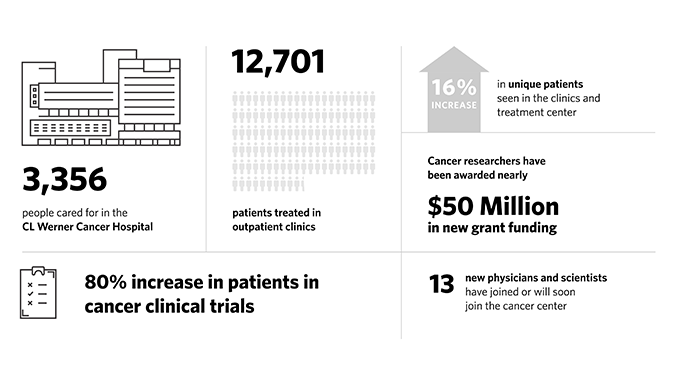
Cancer's Formidable Adversary: Research and Clinical Care Under One Roof
Patients, Clinicians and Researchers Sharing the Same Space
A patient with cancer walks through the doors of the Fred & Pamela Buffett Cancer Center on their way to treatment. Beside that patient are both the clinicians who will provide care and the researchers on their way to the labs to investigate new therapies and discoveries — they are all in the same building. At lunch in the cafeteria, the patient’s family is eating at a table ten feet away from two researchers who are discussing the impact their work may have on the care that the clinician, who is also at their table, is providing that day.
The new cancer centre in Omaha, Nebraska, a collaborative effort between the University of Nebraska Medical Center and its clinical partner, Nebraska Medicine, is the most integrated cancer centre in the world designed using translational medicine — combining clinical care and research within the same facility — to remove the barriers to knowledge exchange and drive the sharing of knowledge between various components of the discovery process.

The research and clinical teams are housed in the Knowledge Center between the clinical and research components of the building. A number of well-integrated cancer centres have the first three levels of integration, but the Fred & Pamela Buffett Cancer Center is the only one that actually integrates the workplace of clinical and research teams.
“Clinicians, researchers, patients and their families all come in through the same doors. We share the same elevators and we walk the same hallways, but we also share the same unlimited hope. The opportunity for streamlined research abounds when everyone is in the same space.”
— Kenneth Cowan, MD, Clinical Oncologist & Director, Fred & Pamela Buffett Cancer Center
Dr. Cowan said the social interaction opportunities that a shared space provides are unlimited and unknown. These intersections between clinical care and research that have not been as readily accessible in the past as they are today with the new cancer centre.
“Even when the research building is next to the clinical building, that is still a bit of a journey. If I, as a clinician, want to talk with a researcher, I have to go down an elevator and walk over to their office and that takes time. That requires a scheduled meeting. In this new facility, I can drop in and see if the researcher I’m looking for is in their office, and if they’re not, it’s not a big deal. We share the same hallways. I can come back and check later without wasting the valuable time that I need to prepare for my patients.”
— Dr. Cowan
All cancer services and therapies are located off of a single elevator bank. This breaks down the proximity barriers to the specialists in these therapies from sharing knowledge and observations related to specific patients and diseases. These therapies are often given in combination and much of the clinical research is looking at the efficacy of, for example, a targeted therapy and radiation.
Regarding the clinicians, nurses and researchers, he said:
“We want them all working together. We want them educating each other about what the problems are for the patients and what’s going on in the research laboratories to help patients sooner rather than later.”
Research takes time. Anything that can be done to speed up the process of discovery will benefit patients and that is exactly what the new cancer centre will allow. Patients are also granted the added benefit of the Healing Arts Program
Glass artist Dale Chihuly created the artwork in the Chihuly Sanctuary, a greenhouse-like, two-story section of the cancer centre with views of the exterior healing garden. Colourful glass flowers and sculptures swirl and point upward throughout the sanctuary. On the top of the flowing extension is a meditation cone. Benches for reflection encircle the floor while sculpted, glass-like, icy leaves curl around the cone walls toward the open top where passing clouds drift by.
An alcove beside the meditation cone holds Dr. Cowan’s favourite Chihuly work — paint on layered, multi-paned glass that plays with light and density to highlight deep, saturated colour and detail. Chihuly calls these works “Glass on Glass,” and this is their first display.
“This is a dream come true.”
— Dr. Cowan
Dr. Cowan, who spent 21 years in public health service at the National Cancer Institute, where his experiences drove him toward genomics and precision medicine’s ability to use “genomic information from each patients’ tumor to understand what in particular is driving that individual’s cancer.”
With patient migration and training completed, the Fred & Pamela Buffett Cancer Center is now open and the work of almost a decade can begin, and every care provider is focused on developing the next discovery and enhancing the patient experience.
